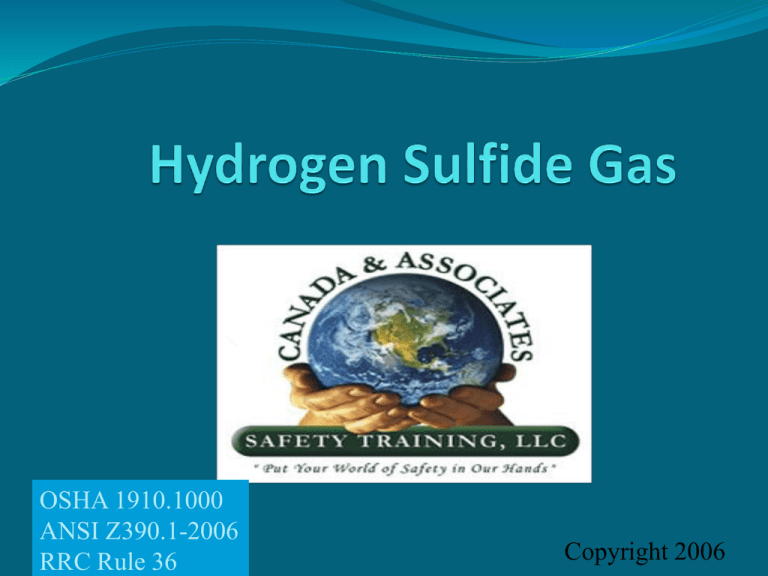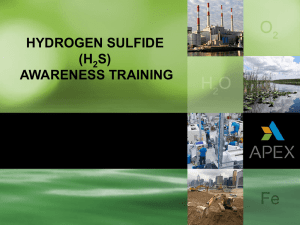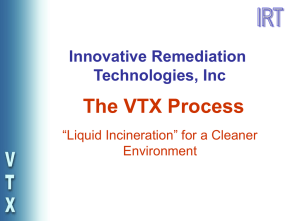Hydrogen Sulfide Gas
advertisement

OSHA 1910.1000 ANSI Z390.1-2006 RRC Rule 36 Copyright 2006 Training Goals for Year 2010 !!!!!! • Development of knowledgeable and competent employees who may be exposed to a sudden release of Hydrogen Sulfide gas. • Provide complete and consistent training to industry (Petroleum, Industrial, Municipal) 2 This class is in accordance with ANSI-Z390.1-2006 Accepted Practices for Hydrogen Sulfide (H2S) Safety Training Programs I. Physical & Chemical Properties II. Work Procedures III. Methods of Detection & Monitoring IV. SCBA (Hands On) V. Human Physiology VI. Respiratory Protection VII. Final Exam for Certification Why am I getting this information? Hazardous Communication is required by Federal Law. 1910.1200 So you are properly prepared for release of hazardous chemicals. (H2S) Copyright 2006 IT’S THE LAW ! In the State of Texas, all persons working in the oil field where H2S concentrations are known, MUST complete a H2S certification course annually. The objective is to educate employees about the physical & chemical properties, toxicity, concentration levels, personal protective equipment use, detection measures, rescue and first aid. The best way to reduce the chance of employee exposure to H2S is to provide the best possible training, provide appropriate personal protective equipment, and ensure employees follow correct work procedures, rules and requirements. WHO………COUNTS………ON……….YOU ? Who Counts On You? Copyright 2009 Oh Yeah, by the way: Hydrogen Sulfide Gas is a toxic (poisonous) gas that can kill you the first time you breath it! 7 What is H2S? H2S is naturally occurring chemical produced by bacteria as it decomposes organic material. It may develop in low oxygen environments, such as, sewers, swamps and polluted water. S H H It is a natural Product of Decay or Putrefaction You may find H2S in: Dairies Breweries Chemical processes Geothermal exploration Fisheries Tanneries 72 different Industries 9 Other Names for Hydrogen Sulfide H2S Sulfurated Hydrogen Swamp Gas Sour Gas Rotten Egg Gas Sewer Gas Stink Damp Meadow Gas Hydrosulfuric acid Dihydrogen sulfide 10 Physical Characteristics Color – Clear/Transparent Odor – Sweetish taste, unpleasant odor; described as rotten eggs. 11 Vapor Density The weight of a gas as compared to air. Air = 1 H2S = 1.189 @ 32 F 19% heavier than air 12 Hazardous Characteristics Flammable 0% 4.3% LFL LEAN 100% BURN RANGE UFL 1% = 10,000 PPM RICH 13 If You take the chance … and Reject the Training, Safe work practices, and Safeguards that are in place. Then Prepare, for the Fate that Follows !! Auto Ignition Temperature Hydrogen Sulfide will automatically ignite at 500 0F End of lit cigarette – 1400 0F Diesel exhaust – 600-2400 0F How do we control this toxic gas? Engineering Controls Ventilation Natural Manufactured Flare Stack Venting PPE Supplied Air Respirator SCBA Work line Escape Pack Loco Hills, NM What else can we do? Tail gate meetings Education Buddy System Be Wind Aware Eliminate Ignition Sources Keep non-essential personnel out of area Checking Safety Equipment Supplied Air Sources Self Contained Breathing Apparatus (SCBA) Air Trailer – Work-line By-products of Burning When H2S is burned, it produces Sulfur Dioxide • Short-term exposures to high levels of sulfur dioxide can be life-threatening. Exposure to 100 ppm of sulfur dioxide is considered immediately dangerous to life and health (IDLH) • PEL for SO2 is 2 ppm • Sulfur Dioxide may cause heart problems and respiratory disorders in younger children and elders. Flare stack If the flare stack is burning away 100,000ppm H2S and is burning at 80% efficiency, what is the ppm of H2S in the exhaust plume? 100,000ppm. The flare stack is burning 80% of the volume not the concentration. Iron Sulfide H2S reacts with iron and steel which forms iron sulfide which can be Pyrophoric ! Iron sulfide treated with acids results in H2S being released. 21 Hazardous Characteristics Corrosive H2S dissolves in water to form a weak acid that corrodes and pits metals. 22 Metallurgy H2S may react with iron and steel causing hydrogen embrittlement and/or sulfide stress cracking. This lowers safety factors in tubular and pressure vessels. 23 Hazardous Characteristics Toxic H2S is the second most toxic gas known to man. The most toxic is Hydrogen Cyanide PEL of H2S = 10 ppm PEL of HCN = 10 ppm 24 Target Organs Lungs Eyes Nose Respiratory control center Liver 25 Variables that determine the effects of H2S exposure 1. Time (how long) 2. Concentration (how much) 3. Frequency (how often) 4. Variables associated with the individual. 26 Individual Variables Age Body mass Physical Condition Drug/Alcohol Compatibility Smoker/Non-Smoker 27 What is a Part Per Million (ppm)? One part in a Million Parts. 1 / 1,000,000 0.0001 1 ounce in 31.25 tons 1 minute in 1.9 years 1 drop of Vodka in 80 fifths of 7-up. 28 Exposure Levels PEL – 10 ppm / 8hr. TWA PEL – 6.6 ppm / 12hr. TWA PEL – 5 ppm / 16hr. TWA STEL – 15 ppm / 15 min. Ceiling Concentration – 50 ppm / once 10 min. Human Lethal Concentration 100 - 800 ppm / 5min. Revised IDLH – 100 ppm 29 • ELECTRONIC • CHEMICAL REACTION • NOSE • The API-55 recommends that monitors be calibrated at least once a month. • They should be calibrated after each use with a Cal-Gas up to 50% of the maximum scale of the instrument. A 10% variance is allowed. 30 Nose Not Reliable Olfactory Accommodation/Paralysis Occurs About 50-100 ppm. A Good Method for Getting Killed! 32 Fixed Monitor Personal Monitors Personal Monitor Limitations The battery and sensor are sensitive They work from a chemical reaction. The reaction uses the chemical up. When the chemical is used-up, the battery or sensor dies. 34 When the alarm sounds, leave the area to a safe zone and not return until the area is SAFE. 35 Contingency Plan Evacuate in an upwind / uphill direction. Report to briefing area immediately. Do not return to the area until someone using proper detection equipment has re-evaluated the area and approved it safe to re-enter. 36 H2S Signs Do not be misled by signs reading caution H2S or warning H2S. H2S may be present H2S may be present Because of the characteristics of the gas. It has the ability to accumulate in levels above IDLH (100ppm). 37 H2S Signs Poison gas 38 39 Possible Danger - No Alarms. All personnel on location must have a current one year H2S certificate from a formal H2S course. Beards & sideburns must be trimmed as necessary to assure the seal on the SCBA face piece will be free of hair. Upon arrival at well site, report to supervisor to receive H2S briefing. • Familiarize yourself with the site’s Contingency Plan. • NO SMOKING except in specifically designated areas. • Inspect & practice putting on your specific breathing apparatus. • Know the location of the “Safe Briefing & Assembly Areas.” • Remain “Wind Conscious” at all times. Be prepared to move across and “Upwind” in the event of an emergency involving an H2S release. 40 Moderate Danger - Intermittent Audible Alarm and Yellow Flashing Light. 10 - 50 ppm H2S • Go to “UPWIND” Safe Briefing Area if you are not specifically designated to control the well. • Be alert for change in weather conditions. • Check your safety equipment for readiness. • During an emergency, use the ”BUDDY SYSTEM” to prevent anyone from entering or being left alone in a contaminated area. • Report any indications of H2S to a supervisor. • Extinguish ALL SOURCES OF IGNITION after an alarm has been activated. 41 Extreme Danger - Continuous Audible Alarm and Red Flashing Light. > 50 ppm H2S • Same precautions as in Condition “Yellow.” • Don your SCBA. • Remain in Safe Briefing Area or Assembly Area and await instructions for evacuation. • Provide assistance to anyone who may be injured by toxic gases. • Personnel shall ensure that their breathing apparatus is properly fitted and operational before entering an H2S contaminated area. 42 Rescue Rescue requires rescue training and practice drills. NEVER attempt a rescue you are not properly trained for. 43 Review ANSI PEL = ANSI STEL= 10 PPM 15 PPM ANSI IDLH= 100 PPM The wind is blowing 20 mph from the N. Which SBA would you go to and how would you get there? SBA SBA 45 WHICH WAY TO GO? SOURCE OF H2S CONCENTRATION DECREASES AWAY FROM SOURCE WIND DIRECTION CONCENTRATION DECREASES FROM CENTER GO CROSSWIND AND UPWIND! IS 8 PPM H2S REALLY SAFE? BYE, BYE AIR! OUTFLOW LINE HIGH PPM H2S H2S AIR HIGH PPM H2S H2S 8 PPM OUTFLOW HIGH H2S H2S H2S H2S HEAVIER THAN AIR H2S STORAGE TANK









